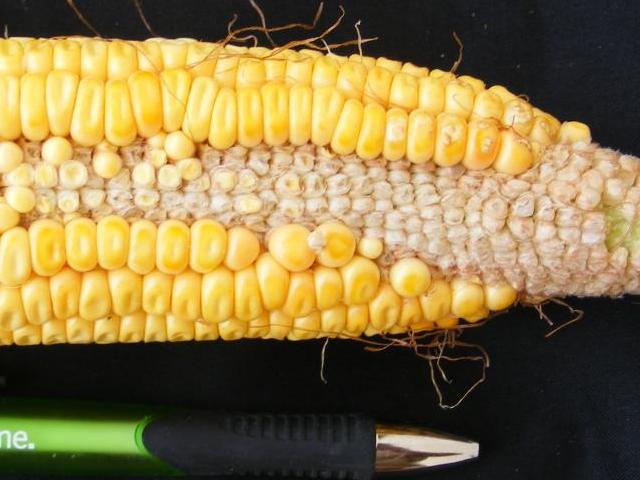August 29, 2018

Source: Ohio State University
By Peter Thomison, Allen Geyer, Bruce Ackley, Alyssa Lamb, and Alison Peart
Although ear and kernel development appears excellent in many Ohio cornfields, there are reports of incomplete ear fill that are related to poor pollination and kernel abortion. Several factors may have caused this problem. The ovules at the tip of the ear are the last to be pollinated, and under stress, only a limited amount of pollen may be available to germinate late emerging silks. Pollen shed was complete or nearly complete before the silks associated with the tip ovules emerge. As a result, no kernels may be evident on the last two or more inches of the ear tip. Uneven soil conditions and plant development within fields may have magnified this problem. Pollen feeding and silk clipping by corn rootworm beetles and Japanese beetles can also contribute to pollination problems resulting in poorly filled tips and ears.
If plant nutrients (sugars and proteins) are limited during the early stages of kernel development, then kernels at the tip of the ear may abort. Kernels at the tip of the ear are the last to be pollinated and cannot compete as effectively for nutrients as kernels formed earlier. Although we usually associate this problem with drought conditions, the stress conditions that occurred this year, such as N deficiency, excessive soil moisture and foliar disease damage, may cause a shortage of nutrients that lead to kernel abortion. Periods of cloudy weather following pollination, or the mutual shading from high plant populations can also contribute to kernel abortion. Agronomists and farmers characterize the poor pollination and kernel abortion that occurs at the tip of the ear as “tip dieback”, “tip-back”, or “nosing back”, although poor pollination is usually the factor affecting poor kernel set at the tip. Kernel abortion may be distinguished from poor pollination of tip kernels by color. Aborted kernels and ovules not fertilized will both appear dried up and shrunken; however aborted kernels often have a slight yellowish color.
“Zipper ears” are another ear development problem evident in some fields. Zipper ears exhibit missing kernel rows (often on the side of the cob away from the stalk that give sort of “a zippering look on the ears”). The zippering is due to kernels that are poorly developed and/or ovules that have aborted and/or not pollinated. Zippering often extends most of the cob’s length and is often associated with a curvature of the cob, to such an extent that zipper ears are also referred to as "banana ears". Zipper ears are often associated with corn plants that have experienced drought stress during early grain fill. Ohio studies indicate that some hybrids are more susceptible to zippering than others are and that zippering among such hybrids is more pronounced at higher seeding rates. Zippering has also been observed in corn plants subject to severe defoliation during the late silk and early blister stages.
For a 3D model showing a zipper ear, see the following
http://u.osu.edu/mastercorn/zipper-ears/
Use the cursor to view the zipper ear model from different perspectives.
For more information and pictures of other ear and kernel abnormalities, check the following: “Troubleshooting Abnormal Corn Ears” available online at http://u.osu.edu/mastercorn/
You May Also Like




